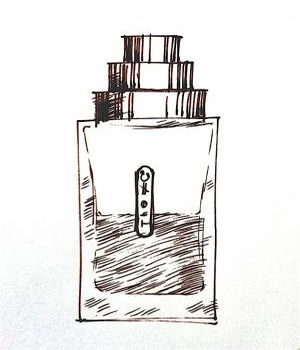Tagged With ‘Mitsouko’
Different Company
Osmanthus
8 July, 2014
 Much excitement in Weymouth, as the old Woolworth’s site has been transformed into a branch of T.K.Maxx. Even more excitement when, on our first visit, what should I pluck from the trashy mass-market scents you’d expect to find in a discount outlet but a brand-new bottle of Osmanthus by The Different Company.
Much excitement in Weymouth, as the old Woolworth’s site has been transformed into a branch of T.K.Maxx. Even more excitement when, on our first visit, what should I pluck from the trashy mass-market scents you’d expect to find in a discount outlet but a brand-new bottle of Osmanthus by The Different Company.
What a highly collectible perfume by a fairly obscure, high-end brand was doing in the Weymouth branch of T.K.Maxx I have no idea, but there it was, ours for the princely sum of £16.99 (recommended retail price €142).
Created by the much-admired perfumer Jean-Claude Ellena (now the in-house perfumer for Hermès) for the company he founded in 2000, Osmanthus gets an admiring review in the even more widely admired Perfumes: The Guide by Luca Turin and Tania Sanchez, and you can see why.
It’s a gentle, sweet but subtle scent, whose plush peachy centre is reminiscent of Guerlain’s timeless Mitsouko, though it seems to lack either Mitsouko’s strength of character or its mysterious staying-power. Yet Osmanthus has magic of its own, and its apparent evanescence on the skin proves something of a disappearing trick – for after putting a little on the back of my hand and noting that it didn’t seem to last very long, what should happen but that an hour or two later, as if from nowhere, its fresh, fruity scent would suddenly snap into focus again, almost as strong as when I first sprayed it on.
I’ve no idea how it’s done, or even whether the effect was intentional, but my guess is that it’s got something to do with the way Osmanthus’ peachiness bonds with the perfume’s other elements, some of which are a little surprising, like castoreum, a resinous compound extracted from beavers that has a leathery, animalic smell and is also found in Chanel’s wonderful Cuir de Russie.
Natural osmanthus, incidentally, is an attractive evergreen shrub which, in sheltered conditions, will grow to the size of a small tree. It grows wild in the Himalayas, China and Japan and was first introduced to European gardens in 1771, where it became known as Sweet Tea or Fragrant Olive. In the autumn it bears thousands of small but intensely fragrant white flowers, whose intoxicatingly sweet scent gives the plant its botanical name, Osmanthus fragrans.
Its fragrance, indeed, is remarkably powerful, as we discovered on an autumn visit to the enchanted garden of Brécy, near Bayeux. From the massively stepped levels of the formal gardens, which form a kind of vast single staircase up towards the Normandy sky, we recognised osmanthus’ heady scent a long time before we finally located its source, from a couple of dark columnar trees planted close against the south wall of the church, outside the gardens themselves.
Despite the sheer intensity of its fragrance, this is one of the only powerfully sweet scents I know that one can never smell enough (unlike, say, Madonna lilies, whose scent becomes overwhelming after a while): there’s a fresh lemony edge to osmanthus that makes it refreshing and intoxicating all at once. Enjoy Jean-Claude Ellena’s perfume by all means, but plant the tree wherever you can.
Obscurity vs. celebripongs
30 October, 2012
What makes a perfume desirable? Why do we buy what we buy? I think it depends on what kind of person we are, or rather how much we know.
Take the person who doesn’t know much about perfume at all. If you don’t know much then you’re likely to buy whatever scent is being most heavily marketed that month, for where else are you going to get your information? Certainly not from the vacuously rehashed press-releases that count as perfume ‘journalism’ in the majority of magazines.
That might sound like a bad thing, and given the number of awful fragrances out there, on the whole it probably is. But then you have to remember that while it might mean that millions of people are buying the latest celebripong, Chanel No.5 remains the single most heavily marketed perfume on earth, so it’s not necessarily all bad news. The drawback, of course, is that you generally end up smelling like everyone else.
Next step up are those of us (and I count myself among their number) who know their Millionaire from their Mitsouko. We’re perfume enthusiasts, we’ve read our Luca Turin, we love the classics and trying new things, but we really want to stand out from the crowd.
So the perfect perfume for us is something that is, ideally, made by an obscure little company with a funny name, or (even better) is a classic fragrance that has long been discontinued or is no longer available in our country, though fortunately we know where we can still get our hands on a bottle or two. Christian Dior’s Jules, anyone? (Yes please.)
But I suspect there’s still another level above this, a kind of perfume nirvana, rarely achieved except by those fortunate few whose olfactory sense is sufficiently sophisticated to distinguish dross from gold. These higher beings can – and here I can only guess – somehow blank out the ads, the breathless copywriting and all the other extraneous noise that deafens most of us to the only thing that really matters in the end: the smell.
It’s as hard to smell a perfume with an open mind as it is to look at a well-known painting or listen to a famous piece of music with an open eye or ear. But surely it’s an ideal to aim towards, even if you end up wearing Guerlain one day and Lady Gaga the next.